Avernum: Escape from the Pit is a new RPG from indie developer Spiderweb Software, and for many of you that name alone is more than enough information. Spiderweb specializes in old-school RPGs from the golden days of 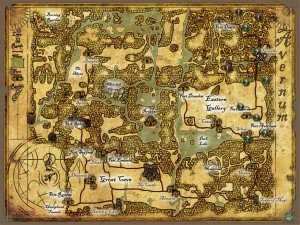 classics like Baldur’s Gate. Amongst their past hits are Avadon: The Black Fortress, the Geneforge series and, most importantly, the Exile series, which was remade into the Avernum series and remade again for the game featured in this review. Spiderweb games are always focused on gameplay and world-building first, while other things like graphics and UI tend to get shifted to the side. Fortunately for more casual RPG fans, Spiderweb took a big step towards making their games a little more user-friendly and accessible in Avadon, and Avernum is another step in the right direction.
classics like Baldur’s Gate. Amongst their past hits are Avadon: The Black Fortress, the Geneforge series and, most importantly, the Exile series, which was remade into the Avernum series and remade again for the game featured in this review. Spiderweb games are always focused on gameplay and world-building first, while other things like graphics and UI tend to get shifted to the side. Fortunately for more casual RPG fans, Spiderweb took a big step towards making their games a little more user-friendly and accessible in Avadon, and Avernum is another step in the right direction.
Avernum is a remake of a prior game called Avernum, which was itself a remake of a game called Exile. The two earlier versions are fairly archaic in their design and graphics, which makes the idea of a polished and updated remake with the engine used by Avadon particularly appealing. The game begins by allowing you to create a party of four adventurers who have been cast into the portal to Avernum, a mystical underground world used as a prison for dissenters and critics of the evil empire. The majority of people down in Avernum have decided to make the best of it and carve out a new life, but others plot to escape and get their revenge on the empire. The world of Avernum itself is tremendously dangerous, partially due to the destructive creatures that are found in the darkness, but mostly due to the empire’s policy of chucking down any creatures or humanoids who look like they might cause trouble. 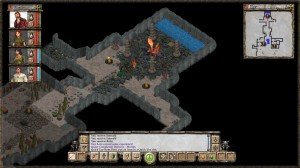 There are scarce supplies and scant natural resources, and even food can be a big problem down in the depths. The game presents this fascinating world by showing it as resourceful but slightly desperate. Despite the fantasy setting, there are definitely vague overtones of Fallout.
There are scarce supplies and scant natural resources, and even food can be a big problem down in the depths. The game presents this fascinating world by showing it as resourceful but slightly desperate. Despite the fantasy setting, there are definitely vague overtones of Fallout.
Once the game has explained the backstory, it just drops you into the world. While there is an overarching plot to follow, the main goal of the game is simply to adventure from town to town and make a name for your adventuring band. It’s not quite the “go anywhere!” attitude of games like Skyrim, as some areas will destroy a weak party, but the story structure doesn’t consist of much beyond solving the problems of each town as you get there. The game is very well-written, with plenty of dialogue and text, but the opportunities to “role-play” are almost nonexistent, as the key to every conversation is to pick almost every dialogue option in order. While the world has this unique, cool, desperate, fantasy-frontier style, the actual storyline of the game doesn’t match up. However, this isn’t necessarily a fault.
There is a lot of emphasis placed on RPGs that create “real” worlds that feel lived-in, but the world of Avernum does not capture that feeling at all. If you want to compare it to anything, 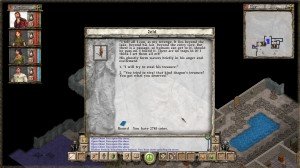 you could say Avernum is a lot like a well-done Dungeons and Dragons adventure, as it has an extensive world built up that seems entirely crafted to give your party something to do. Nearly every NPC offers some kind of hint or quest hook for an adventure, and the dialogue even feels like it was pulled from a particularly well-written Fighting Fantasy book. Every little cave on the world map offers some kind of dungeoneering adventure for loot and sweet experience points. Every world map encounter offers some kind of distraction, whether it be riches or baddies to kill. The game almost perfectly captures the tabletop RPG style by creating a world solely based around your party and their epic adventures, and the choices come from how you approach each adventure. Do you sneak into the bandit fort through the rear? Grab the blood-red dagger on the altar made of bones? Slaughter the eggs of a particularly warlike band of lizardmen? It’s very binary, but in a tabletop RPG fashion which gives the game a unique edge.
you could say Avernum is a lot like a well-done Dungeons and Dragons adventure, as it has an extensive world built up that seems entirely crafted to give your party something to do. Nearly every NPC offers some kind of hint or quest hook for an adventure, and the dialogue even feels like it was pulled from a particularly well-written Fighting Fantasy book. Every little cave on the world map offers some kind of dungeoneering adventure for loot and sweet experience points. Every world map encounter offers some kind of distraction, whether it be riches or baddies to kill. The game almost perfectly captures the tabletop RPG style by creating a world solely based around your party and their epic adventures, and the choices come from how you approach each adventure. Do you sneak into the bandit fort through the rear? Grab the blood-red dagger on the altar made of bones? Slaughter the eggs of a particularly warlike band of lizardmen? It’s very binary, but in a tabletop RPG fashion which gives the game a unique edge.
Combat is also heavily influenced by tabletop RPGs as well. At the first sign of danger, the game turns the map into a grid-based battlefield where you control your characters one at a time to attack, cast magic, run about and do the same sort of thing you would do in the average D&D turn. For the vast majority of the time, the combat is quite satisfying – never easy enough that you could sleep through it, yet never too difficult to overcome with the clever use of spells and positioning. Each fight is essentially a short, fun, tactical bout that wouldn’t look out of place on a particularly nerdy game night.
The main fun of the game outside of combat is building and developing your characters. While the game asks you to pick a class for each of your four heroes, the starting class does little more than lock in your first few skill points for a fairly balanced build. Anyone can learn anything, which can lead to some very cool combinations. The game has the usual slew of basic stats like strength and intelligence, but on top of that you have a skill system and a collection of traits. 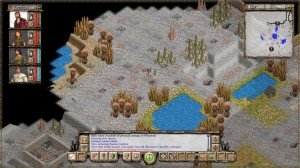 The skill system is what you’d expect from most RPGs, where you add a couple of points at each level into things like how skilled you are with blades, or how well you unlock doors, or just how high a level of spell you can learn. The traits system, on the other hand, is brilliant. Reminiscent of the perks system found in games like Fallout, each trait lets you pick and add a unique and powerful facet to your character. Some of them are just basic things like a skill boost, but many of them can completely change how you play a character. For example, one perk allows your magic characters to wear heavy armour with no negative effects, so a brutal mage tank slinging spells and swinging swords up-close is entirely possible and encouraged. Another example is the backstab perk, which is a rogue character staple but can be added to a pair of warriors instead to make them nearly unstoppable when teaming up on a single enemy. Sure, there are “ideal” builds, but it’s very hard to completely screw up your skills, which means experimentation can be rewarded with some awesome and unique characters.
The skill system is what you’d expect from most RPGs, where you add a couple of points at each level into things like how skilled you are with blades, or how well you unlock doors, or just how high a level of spell you can learn. The traits system, on the other hand, is brilliant. Reminiscent of the perks system found in games like Fallout, each trait lets you pick and add a unique and powerful facet to your character. Some of them are just basic things like a skill boost, but many of them can completely change how you play a character. For example, one perk allows your magic characters to wear heavy armour with no negative effects, so a brutal mage tank slinging spells and swinging swords up-close is entirely possible and encouraged. Another example is the backstab perk, which is a rogue character staple but can be added to a pair of warriors instead to make them nearly unstoppable when teaming up on a single enemy. Sure, there are “ideal” builds, but it’s very hard to completely screw up your skills, which means experimentation can be rewarded with some awesome and unique characters.
The graphics, on the other hand, are generally mixed. The game looks like it was released in 1998, but in fairness, it’s a huge step forward for Spiderweb and looks leagues better than the first Avernum remake. In particular, the character art and the paintings used for important cutscene moments are beautifully done. The actual game itself looks old but decent, with a generally cool and unique style that reflects the atypical underground ecosystem of the world. The visuals do tend to get slightly addled by the fog of war, which makes walls, doors and people disappear on occasion, but it’s not a huge deal. The graphics are not a high point overall, but chances are that if you’re in the market for a retro tactical RPG like Avernum, that’s not going to be a major deal for you.
There are a few nitpicks which must be mentioned, but luckily they are indeed few. The journal is essentially useless, as it only records the first step of any quest you accept. The game offers a button that will record any dialogue you receive into your journal, but the quests themselves don’t even tell you whether or not you’ve completed them. 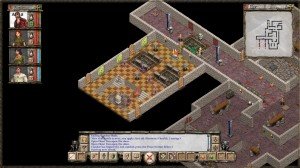 We’re guessing it’s part of the design to make Avernum less inclined to hold your hand, but a bit of leeway would be nice, and the game winds up pulling plenty of hand-holding moves regardless by marking quest locations on your map. The other main issue is the balance, as martial characters are at a huge disadvantage. When up against powerful enemies, melee and ranged characters can have as little as a twenty percent chance to hit, but magic will almost always hit regardless. As long as you stay fighting enemies that are on par or far weaker, you’ll be fine. Your characters will finish all the quests a while before they out-level areas, which pushes you towards more powerful enemies. Unfortunately, these enemies are frustratingly impossible to hit. You will notice this towards the middle of the game, but if you persevere with your characters, they will become powerful demigods who can take on the tougher challenges without any major issues. The final quirk is the UI, which is not too bad compared to older Spiderweb titles, but can be a bit unintuitive and unhelpful in terms of keyboard shortcuts.
We’re guessing it’s part of the design to make Avernum less inclined to hold your hand, but a bit of leeway would be nice, and the game winds up pulling plenty of hand-holding moves regardless by marking quest locations on your map. The other main issue is the balance, as martial characters are at a huge disadvantage. When up against powerful enemies, melee and ranged characters can have as little as a twenty percent chance to hit, but magic will almost always hit regardless. As long as you stay fighting enemies that are on par or far weaker, you’ll be fine. Your characters will finish all the quests a while before they out-level areas, which pushes you towards more powerful enemies. Unfortunately, these enemies are frustratingly impossible to hit. You will notice this towards the middle of the game, but if you persevere with your characters, they will become powerful demigods who can take on the tougher challenges without any major issues. The final quirk is the UI, which is not too bad compared to older Spiderweb titles, but can be a bit unintuitive and unhelpful in terms of keyboard shortcuts.
Avernum is an RPG straight from the past but with enough modern concessions to make it very fun today. Despite some quirks, it’s a game that almost perfectly captures the feel of a good old-fashioned tabletop D&D session, with a world that’s fun to explore and plenty of evil butt to kick. If you have a thing for older RPGs, Spiderweb’s latest offering does not disappoint.
Rating: 









This review is based on a review copy of Avernum provided by Spiderweb Software.


Pingback: Review: Avernum: Escape from the Pit | Game Review Guide()